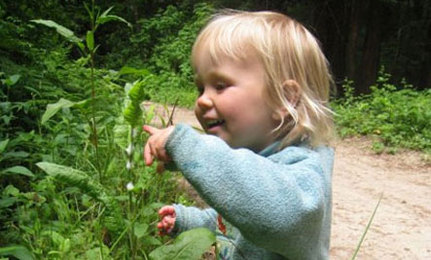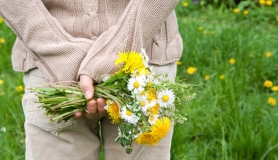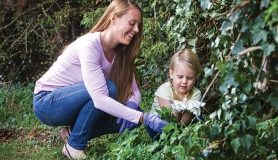Gardening for wildlife is also a wonderful way to get your kids involved in ecology in a very hands-on and exciting way. People shy away from creating wildlife gardens for a number of reasons but one of the main ones is space, or lack of it. You don’t have to create a huge wildflower meadow; you can make very successful wildlife havens in containers on a patio or even on a windowsill. The kind of wildlife you attract to your space will depend on how much you have available but being open-minded to all your little visitors should open you up to some lovely surprises! Just like us, visitors to our gardens have three basic needs: food, water and shelter.
Feeding the birds
One of the easiest and most rewarding ways to attract more wildlife to your garden is to make a bird feeder. You can buy them from most garden centres but it is far more rewarding to make your own. Find yourself a few large pine cones and attach a string to the top of them. Cover the cones in peanut butter, filling all the cracks and crevices. Roll the covered pine cone in bird seed and hang from a tree or window-sill for birds to feed from. You can adapt this recipe and use melted suet or lard instead of the peanut butter. You can also make a simple birdseed feeder using an old, clean plastic bottle. Never put out salted nuts or seeds for your birds as this can seriously dehydrate them. Birds need water as well as food so always make sure they have a supply of fresh, clean water available for them to bathe in and drink. It sometimes takes birds a while to become aware of a new ‘feeding station’ so remain patient as they get to know your garden. The rewards when you have many visitors a day are wonderful.
Bed and breakfast
Your garden visitors need somewhere to go for shelter, warmth, protection, to rear their young and/or hibernation. Many animals create their own nesting environments (rabbits dig warrens; badgers create setts etc.) but there are many ways in which you can help them find somewhere to call home.
Hedgehogs: Cover an upturned crate with stones, earth or wood, making sure that there is space to get in and out and it is sturdy enough to deter predators like foxes and badgers. Compost heaps and log-piles are hedgehog favourites as are damp, grassy areas to forage in. Always check a bonfire before lighting it as hedgehogs often make their homes here. The best homes for hedgehogs – and many other wild creatures – are undisturbed piles of garden ‘rubbish’: you’ll find that one of the best ways to create a wildlife haven is to try not to be super-tidy in the garden!
Birds: A bird nesting box can be a great construction project for older kids, or can be purchased fairly cheaply. See the BBC website for building tips. Situate your box over 2m high for protection from predators and not in direct sunlight to prevent baby birds from overheating. Boxes will need to be cleaned after they have been used, ready for the next inhabitants. Dense, thorny bushes provide shelter for a range of wildlife. Maintaining hedgerows in and around your property enables birds and small mammals to access both shelter and food in the form of berries and seeds. See rspb.org.uk for more ideas.
The water of life
Creating a pond in your garden can bring in a wide variety of visitors, ranging from pond skaters, damselflies and water beetles to frogs, toads and newts. Frogs and toads are a valuable addition to any garden as they thrive on the kind of insects that devour our favourite plants, such as slugs. You’ll also find that a pond draws in birds who use it to bathe and drink from and night visitors such as badgers, foxes and hedgehogs. Creating a pond doesn’t have to be a mammoth or expensive project, there are lots of online sites with tips and advice eg. veggieglobal.co.uk.
Wildlife in miniature
You haven’t got room for a log pile or pond? Don’t worry, you can attract a dazzling array of butterflies and bees to window boxes and small containers with the right flowers. Choose nectarrich flowers for your flying friends such as: hemp agrimony, sedum, marjoram, lavender, valerian, knapweeds, scabious and cirsium thistles. The campions are a great source of nectar for night-flying moths, as is rosebay willowherb.
The smallest visitors
Dead wood provides a habitat for a huge range of insects, moss and fungi and is possibly the easiest way to invite wildlife into your space. Chop up a few old logs and leave them in a damp, untended area of the garden – you can accelerate their decomposition with some damp earth. Watching this wildlife space literally come to life and charting the arrival of woodlice, spiders, worms, beetles, slugs, snails, mosses and fungi claiming their territory is a fascinating project for both kids and adults. If the idea of attracting slugs and snails into your garden seems like madness, remember they provide valuable sustenance for birds, hedgehogs and toads to name but a few.
THINGS TO DO TODAY:
• Create a log pile for hedgehogs and other small mammals
• Make a bird feeder and put in a water bath for feathered friends
• Plant some nectar-rich flowers that attract bees and butterflies
• Find out what wildlife you have in your area and what habitat/food they need to survive
• Get involved with a local or nation-wide wildlife survey
• Dig a hole for your pond!
The gorgeous image used to illustrate this story shows two-year-old Chloe exploring the nature in her area.







